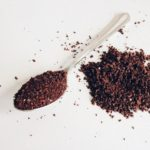All coffee lovers will, at some time, have grappled with the problem of coffee grounds in the sink. Each grain is tiny; but combined with water and other items in your garbage disposal, coffee can result in blocked drains.
You CAN put coffee grounds down the sink, but it often happens that they will clog your pipes. This can be especially detrimental to septic tanks. And since your kitchen sink is one of the locations in your home where bacteria most like to hang out, and blockages can make that worse, you need to know how to handle the situation.
Should You Put Coffee Grounds Down The Sink?
Coffee grinds are so absorbent that they can trap oil, eggshells, and other debris, blocking up pipes surprisingly quickly. Coffee grinds are one of several substances you shouldn’t ever put down the sink.
Coffee Grinds Down The Sink: Basic Plumbing 101
In a typical home, pipes are mainly under the sink in the kitchen, bathroom, or utility. Clean water coming in and wastewater going out are on different circuits (or should be, if you don’t want to get sick). The pipes are kept in place with various fittings, linking to tanks that act as a store or conduit.
One set of pipes transport wastewater away from your home and into the sewers or septic tank. (As an aside, the sewage system made the list of the top 50 inventions of the 20th century in a BBC poll.)
When the system becomes blocked, this impacts the water flowing out of your home. Any part of this system can get clogged up with what goes down the sink. Including coffee grounds.
Pipe Anatomy 101: How To Unclog A Sink
Should you encounter a particularly stubborn blockage, don your rubber gloves (if you haven’t already) and investigate the P-trap. Personally, we’d also turn off the water at the mains before attempting this particular operation.
Time for a little pipe anatomy lesson. Inside the U-shaped pipe under the sink, there’s a little structure called the P-trap. Sometimes it’s just referred to as the U-bend. At either end of this part of the pipe, you’ll see connectors.
Place a bucket beneath the P-trap. You might need a pipe wrench to dislodge the connectors, especially if made of metal. If they’re plastic, a firm grip to unfasten them might be enough.
Make sure that the bucket is positioned to catch any fluid. Pull the P-trap away. Remove any obstructions, then run clear, cold water through the pipe to clear any remaining debris. Check that there are no blockages in the rest of the pipes at the wall and the sink.
Once you’re happy the P-trap is unblocked, replace the pipe and tighten the connections again. Run the water until it runs clear.
How To Deal With A Sink Blocked With Coffee Grounds
If your sink gets blocked, what can you do? There are commercial cleaners available but they often include harsh chemicals that may harm aquatic life.
A more environmentally friendly option is to pour baking soda into the plughole, then add vinegar. In this popular high school chemistry experiment, the gently fizzing foam works its way through the pipes.
You might need to repeat the “vinegar and baking soda” routine more than once to clear the pipes. In severe cases, the mixture might need to sit for an hour or so before running water through.

How To Unclog Kitchen Sink Clogged With Coffee Grinds
One DIY essential is an old-fashioned plunger – usually a wooden stick with a cup on the end. Not sure how to use a plunger to unclog a sink?
Fill the sink. The rubber cup on the plunger should be totally immersed. Double sink? Make sure there’s a rubber plug or drain stop in the second sink, or block it up with a small towel.
Holding the plunger handle with both hands, position the rubber cup directly over the opening of the drain. Push down on the plunger and pull up; around 10 to 15 times to get the drain clear.
We’ve established that putting coffee grinds down the sink or putting coffee grounds in garbage disposal is not a good idea. So what other options are there?
Disposing Of Coffee Grounds In The Garden
Composting is one solution. No access to a compost heap? Some districts run community composting services or have a biomass boiler household food waste collection. Unless you want to encourage mold, don’t add coffee grounds directly to the soil if they haven’t been composted first.
Dried, used coffee grounds also repel some insects and other garden pests like snails and slugs. Mixing coffee grounds with chopped up the citrus peel, especially orange, can also deter cats from using the garden as a litter box.
Reusing Coffee Grounds In The Flower Bed
If you decide to use coffee grounds on your flowers, opt for acid-loving plants. Think roses, rhododendrons, and camellias.
Hydrangeas will love it too – you might even find the color of the flowers changes from bright pink to bright blue. To encourage blossoms and fruit-bearing, you’ll get the best results if you add lime or wood ash.
Reusing Coffee Grounds In The Vegetable Patch
Adding coffee grounds to the fertilizer mix also does great things to carrots. And then there are the mushrooms.
To grow, mushrooms need a substrate or an underlying layer. And coffee grounds, since they’re absolutely jam-packed with nutrients, make a great substrate.
Reusing Coffee Grounds To Grow Mushrooms
Want to grow your own mushrooms? Oysters and shitake work especially well. You’ll need around five and a half pounds of coffee grounds. Prepare a bucket or a grow bag if you prefer, and moisten the coffee grounds with water from a spray bottle. Add about another pound of mushroom spore, a little sawdust, and make sure you stir the ingredients well.
Fill your bucket about two-thirds full. If your bucket has a lid, you’ll need to cut four small holes for air in the sides. Cover open containers with clear plastic and poke a few more holes in the fabric.
Spray the grounds with water once a day. In about two to four weeks you should notice small mushroom buds. The container then needs to be moved to a lighter area with fresher air. You’ll know when the mushrooms are ready to harvest as they’ll become plump with caps turned upwards.
Innovative Ways Of Reusing Coffee Grounds
Other uses might include repairing scratched furniture, using in skin exfoliators or hair rinses, or dyeing a stained shirt. You could also use them to dye eggs for Easter, and even possibly helping your pet get rid of any fleas they might have acquired.
Wonder what the future holds? A couple of enterprising Scots who studied at the University of Strathclyde in Glasgow have found a way to extract oil from the grounds.
Coffee Grounds: Happily Ever After
Millions of bags of coffee are produced every year. Disposing of the grounds, therefore, poses quite a problem. While it might seem an easy answer, flushing them down the sink is not advisable.
For a quick “how to unclog your sink” essentials shopping list, we’d suggest the following. You’ll need a plunger; screwdriver; pipe wrench; bucket; rubber gloves; vinegar and baking soda.
And if you feel like adding a baking tray and a five-gallon bucket, we’re sure you’ll find those in the local hardware store too…though you’ll need to check out the gardening section for mushroom spores and carrot seed.

Hi my name is Larry, a coffee aficionado from the US. I have already visited Colombia, Sumatra, Guatemala, Costa Rica, Ethiopia and Jamaica in my pursuit of finding the best-tasting coffee beans. I currently write from Bali and enjoy the relaxed life that you can only find in Canggu. Welcome to my coffee world!





